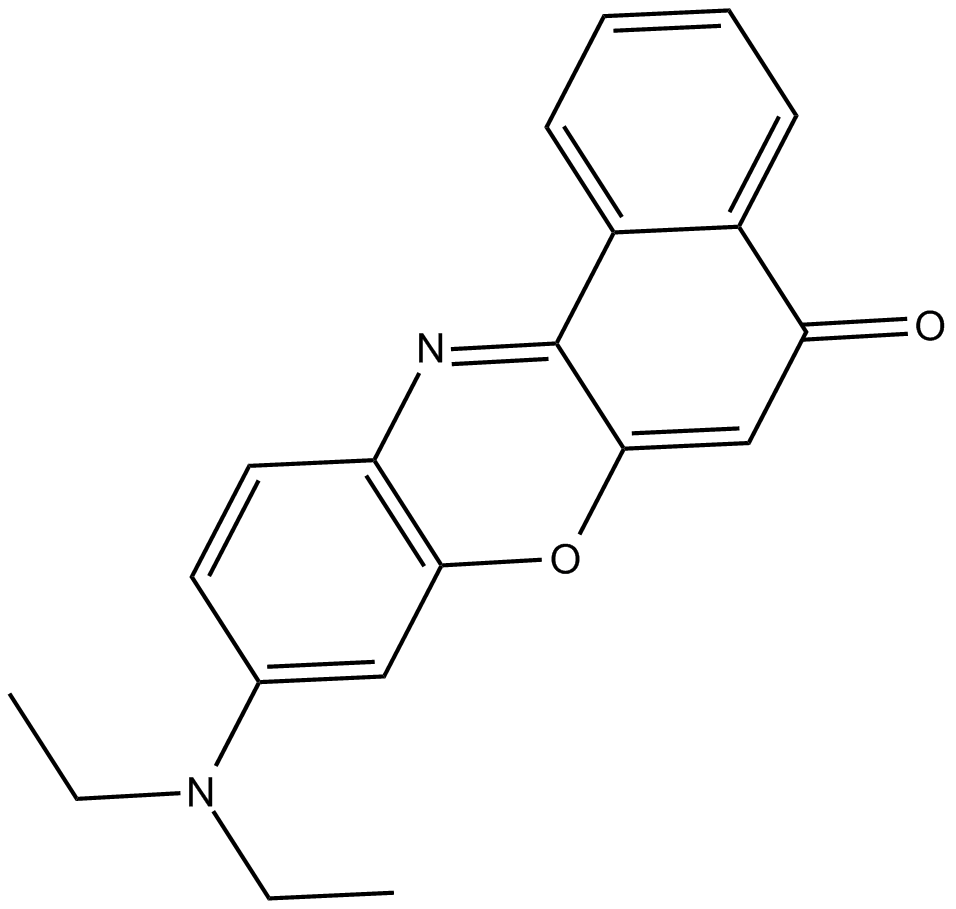Nile Red
|
| Catalog No.GC15539 |
Nile red is a common lipid dye.
Products are for research use only. Not for human use. We do not sell to patients.

Cas No.: 7385-67-3
Sample solution is provided at 25 µL, 10mM.
Nile red is a common lipid dye. Nile red is a hydrophobic and metachromatic dye with poor solubility and fluorescence in water, with colour emission varying from deep red to strong yellow gold in hydrophobic environments [1].
Nile red can dye the cholesterol in the human plasma through staining of lipid vesicles in smooth muscle cells and in cultured macrophages incubated at low density, using the excitation/emission wavelengths 450 to 500/>528 [2]. Nile red was also used to study membrane heterogeneity [3] and ligand-hydrophobic protein surface interactions with the alternative wavelengths 570/610 [4] and to study enzyme mechanism by using the wavelengths 550/640 to 660 [5]. Nile red has also been successfully used to stain intracellular neutral lipids that is, TAG and cholesterol esters in yeast, fungi with coupled wavelengths 488/565 to 585 [6] and also in microalgae, with wavelengths set to 488 to 525/570 to 600 [7] or to stain total lipids with wavelengths set to 490/585 [8].
References:
[1]. Rumin J, Bonnefond H, Saint-Jean B, et al. The use of fluorescent Nile red and BODIPY for lipid measurement in microalgae[J]. Biotechnology for biofuels, 2015, 8(1): 1-16.
[2]. Greenspan P, Mayer E P, Fowler S D. Nile red: a selective fluorescent stain for intracellular lipid droplets[J]. The Journal of cell biology, 1985, 100(3): 965-973.
[3]. Ira and, Krishnamoorthy G. Probing the link between proton transport and water content in lipid membranes[J]. The Journal of Physical Chemistry B, 2001, 105(7): 1484-1488.
[4]. Sackett D L, Wolff J. Nile red as a polarity-sensitive fluorescent probe of hydrophobic protein surfaces[J]. Analytical biochemistry, 1987, 167(2): 228-234.
[5]. Ruvinov S B, Yang X J, Parris K D, et al. Ligand-mediated Changes in the Tryptophan Synthase Indole Tunnel Probed by Nile Red Fluorescence with Wild Type, Mutant, and Chemically Modified Enzymes (∗)[J]. Journal of Biological Chemistry, 1995, 270(11): 6357-6369.
[6]. Kimura K, Yamaoka M, Kamisaka Y. Rapid estimation of lipids in oleaginous fungi and yeasts using Nile red fluorescence[J]. Journal of microbiological methods, 2004, 56(3): 331-338.
[7]. Cooksey K E, Guckert J B, Williams S A, et al. Fluorometric determination of the neutral lipid content of microalgal cells using Nile Red[J]. Journal of microbiological methods, 1987, 6(6): 333-345.
[8]. Lee S J, Yoon B D, Oh H M. Rapid method for the determination of lipid from the green alga Botryococcus braunii[J]. Biotechnology techniques, 1998, 12(7): 553-556.
Average Rating: 5 (Based on Reviews and 32 reference(s) in Google Scholar.)
GLPBIO products are for RESEARCH USE ONLY. Please make sure your review or question is research based.
Required fields are marked with *





